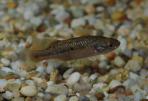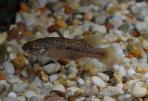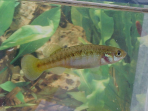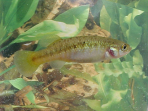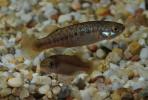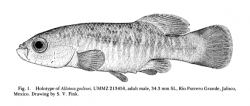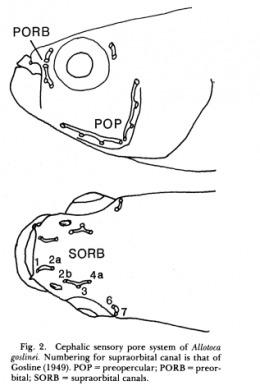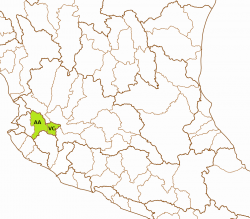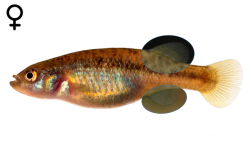- HOME
- WHO WE ARE
- NEWS AND DATES
- GOODEIDS
- PHYLOGENY
- ARTIFICIAL KEY
- GOODEID SPECIES
- BIOLOGY
- ENVIRONMENT
- CONSERVATION
- PROFUNDULIDS
- MEMBERS AREA
Allotoca goslinei
English Name:
Banded Allotoca
Mexican Name:
Tiro listado
Original Description:
SMITH, M. L. & R. R. MILLER (1987): Allotoca goslinei, a new Species of Goodeid Fish from Jalisco, Mexico.Copeia 3: pp 610-616
Holotype:
Collection-number: University of Michigan Museum and Zoology, Cat. No. UMMZ-213450.
The Holotype is a mature male of 34.3mm standard length, collected by R. R. Miller, F. H. Miller & D. I. Lyons on February the 23rd, 1976. It was taken with five mature individuals of both sexes between 28.6 and 40.1mm long, Cat. No. UMMZ-198851, and 16 new born fry from one female Paratopotype with lengths from 9.3 to 12.1mm, Cat No. UMMZ-213395.
The left picture shows a drawing of the Holotype of Allotoca goslinei, the right one a scheme of the cephalic sensory pore system according to W. A. Gosline:
Terra typica:
The Holotype was collected in the Arroyo (Río) Potrero Grande, a tributary of the Río Ameca bout 10km W of the town Ameca on the road to Atenguillo, federal state of Jalisco.
Etymology:
This species is named for William A. Gosline in appreciation for his basic work on sensory canals in cyprinodonoid fishes.
The genus Allotoca was erected by Hubbs and Turner, published by Turner in 1937 and taken from the manuscript of the famous monography about Goodeids that Hubbs & Turner finally published together in 1939. Though the authors mentioned the posterior insertion of the dorsal fin, "the more fundamental characters of Allotoca, however, are ovarian and trophotenial..." The word ἄλλος (állos) means different and τόκος (tókos) offspring, so the genus refers to the different looking trophotaenia of the fry with the generic name meaning "different offspring".
Synonyms:
Neoophorus sp. Uyeno et al., 1983
Distribution and ESU's:
The Banded Allotoca was endemic to the Mexican federal state of Jalisco and historically only known from few collections in the headwaters of the Río Ameca, namely from the type location, the Arroyo Grande or Arroyo (Río) Potrero Grande about 10km W of the town of Ameca, and from the Río Cuisillos, 1km E of the train station at Pacana near the Presa La Vega, where it coalesces with the Río Salado forming up the Río Ameca (Smith and Miller, 1987). From this distribution pattern can be inferred, that it was more widespread in the headwaters of the Río Ameca drainage, but stayed either unnoticed or was very scarce. However, it was eliminated from the Río Ameca by the late 1990's, but remained moderately common in the Río Potrero Grande (Lyons, 2011), until non-native swordtails (Xiphophorus hellerii) invaded the river after the year 2000. Being the dominant species in 2000 with about 75% proportional abundance, the numbers of Allotoca goslinei declined thereafter rapidly, and extensive samplings in 2005 and 2006 didn't show up even a single individual (Helmuset al., 2009). The last record dates back to 2004 (Lyons, 2011). This species is regarded Extinct in the Wild. No subpopulations are distinguished. The bold names are the ones officially used by the Instituto Nacional de Estadística y Geografía; nevertheless, other ones might be more often in use or better known and therefore prefered.
ESU ist short for Evolutionarily Significant Unit. Each unit expresses an isolated population with different genetic characteristics within one species. ESU's can be defined by Molecular genetics, Morphology and/or Zoogeography and help in indicating different phylogenetic lineages within a species. The abbreviation for an ESU is composed of three letters of the genus, followed by the first two letters of the species name and an ongoing number in each species.
All specimens of Allotoca goslinei belong to the single ESU Altgo1.
The left map shows the Presa La Vega-Cocula (VC) and the Río Ameca-Atenguillo (AA) basins from the Hydrographic Region Ameca on a Mexico map. The type location of the Banded Allotoca is located in the Río Ameca-Pijinto subbasin (PIJ), a second collection point is known from the Upper section of the Río Ameca, the Río Salado subbasin (SAL). From this historical distribution pattern, an additional occurence in the Río Cocula subbasin (COC) can be inferred. However, the species has probably been extirpated from all these drainages shown on the right map:
Status :
International Union for Conservation of Nature (IUCN): Extinct in the Wild
Distribution and current conservation status of the Mexican Goodeidae (Lyons et al., 2019): Extinct in the Wild/no records since 2004: „This species was known from only a small tributary of the Ameca River, the Potrero Grande Stream, and the Ameca River itself near the mouth of the stream in the upper Ameca River basin near the city of Ameca (Smith and Miller, 1987). The species had been eliminated from the Ameca River by the 1990’s by water pollution but was still moderately common in the headwaters of the Potrero Grande Stream. In the early 2000’s, the non-native Xiphophorus hellerii (Poeciliidae) became established in the Potrero Grande Stream. As X. hellerii numbers increased, the abundance of A. goslinei dropped rapidly, presumably from competition or predation on larvae. The last specimen of A. goslinei was collected in 2004, and none could be found in targeted surveys in 2005, 2006, 2007, 2016, and 2018 (Helmus et al., 2009; Köck, unpublished data). Based on this, A. goslinei is feared to be extinct in the wild, although it is possible that a small population persists in an isolated area of the stream not yet invaded by X. hellerii. Only a few captive populations exist in Mexico, the United States, and Europe, and all are small.“
NOM-059-SEMARNAT-2010: Categoría de riesgo (Category of risk): P - En Peligro de Extinción (in danger of extinction)
Habitat:
This fish is only known from a quiet pool of this creek right before it dropped into the Río Ameca. The size of the pool was about 23 x 3.2/3.4m and up to 1.2m deep. The species prefered areas with current from slight to none (mainly in the dry season). The water was clear to murky in deeper pools, the depths where this fish could have been found were less than 1.2m. A few species of vegetation were identified, mainly water hyacinths, green algae (abundant) and a Nasturtium-like vascular plant. The ground was made of gravel, sand and mud. The fish occured primarily in shallow water (15-25cm) beneath floating plants. These (small) patches of floating plants did not reach more than 1m into the pool. In the dry-season, the Arroyo Potrero Grande shrinked down to a couple of pools and swamps. In the spring time, the watertemperatures were between 16 and 20°C. The habitat pictures show the creek a few kilometres above the terminal pool where the species was collected.
Biology:
Miller measured 16.4-20°C from mid-February to early March. The smallest fish taken at this time had been 21mm SL on 4 March. Sixteen newborn young from a wild-caught female from this collection were 9.3 to 12.1mm long.
Diet:
The dentition is similar to other members of the genus Allotoca, means conical teeth, the outer row large ones, followed by a narrow band of smaller inner teeth. This suggests this species is hunting for small invertebrates and probably insects from the water surface.
Size:
The maximum known standard length is about 50mm (Miller et al., 2005).
Colouration:
The male shows a dark and elongate spot at midside that lies above the posterior half of the pelvic fin. There may be one or two similar spots anteriorly. Posterior to the single spot are about nine blotches and irregular vertical bars and five or six anteriorly, but these blotches and bars appear only in preservation and juvenile specimens. The living female shows typically three dark spots on the midside, one in the same position as in the male and two positioned anteriorly. The most anterior one lies in front of the pelvic-fin insertion. The female has also got a black spot at the anal fin origin and a smaller one on each side of the vent. In alcool, adults show (at maximum) 18 irregular bars along the midside. It is these numerous lateral bands in both sexes that is reflected in the common english name of this species, Banded Allotoca.
Sexual Dimorphism:
At first appearance, males and females of the Banded Allotoca are not very easy to distinguish. The safest characteristic is the Splitfin in males, means the for Goodeinae typical mating organ formed by a notch after the first seven shortened rays of the Anal fin. Additionally, male Allotoca goslinei have a bigger Dorsal fin than females. A difference in colouration is almost not visible, except for a pink belly in courting females and usually clear stripes on the Caudal peduncle. Those are not so clear visible in males. Females are a bit longer than males with a bigger and blunt head, but some experience is necessary to see these characters. Males appear a bit rectangular as a result of its bigger Anal and Dorsal fins.
Remarks:
From the Potrero Grande creek, Allotoca goslinei has been taken only from the quiet terminal pool, 23m long and between 3 and 4m wide, before the creek emerges from the canyon and drops precipitously to the Río Ameca. Like the sympatric Allodontichthys polylepis, this species disappeared from this creek in the early years of this millenium with the last record from 2004. It is very likely that invasive Green swordtails were the main reasons for the species' disappearance. A survey to this creek by the GWG in 2018 still revealed swordtails in the section close to the street, but no other fish except Goodea atripinnis that has not been reported from the Potrero Grande creek before.
In 2008, O. Domínguez-Domínguez started a semi-captive conservation program with the help from the Fish Ark Mexico Project. An artificial pond on the area of the Botanical garden of the Faculty of Biology from the University of Morelia has been built and populated with Neotoca bilineata and Zoogoneticus tequila in April, and with Allodontichthys polylepis and Allotoca goslinei in August. Though there had been troubles with goslinei in this pool at the beginning, in 2010 it has been present in catches again.
As a reaction on the threats this species is facing, the Austrian Association of Aquarists (ÖVVÖ) started a Studbook on this and all other Allotoca species (including the closely related Neoophorus regalis).
Allotoca goslinei is closely related to Allotoca dugesii and has a common ancestor with Allotoca maculata. With the Blackspot Allotoca being the most basal species, the species pair dugesii/goslinei seems to form a kind of sistergroup to the remaining four, also closely related species from the lagos de Pátzcuaro, Zirahuèn, Zacapu and the Río Santa Catarina (catarinae, diazi, meeki and zacapuensis).
Husbandry:
Looking on the former biotope of Allotoca goslinei, it suggests the species may prefer a habitat with moderate to swift current, structured with gravel, rocks, roots, branches, fallen leaves and river bank vegetation. Fry is eaten in most of the cases, but it may depend on the quantity and quality of food and on the number of places to hide. When several different stages of juveniles occur, fry may be neglected, so it makes sense to add separate brought up fry to the group with a size of 2 or 2.5cm to provide these stages and get a flock breeding colony.
The recommended tank size is at least 100 liters, bigger tanks with a generous base and little height (25cm are enough) are better for sure. With rocks and vegetation in the corners and backsinde of the tank well structured tanks combined with some roots and/or wood seem to do best with this species. The current should be moderate or swift, especially as the species is adapted to a high oxygene level (at least 8mg/l).
In the wild, the species feeds mainly from small or middle-sized invertebrates like bloodworms or insect larvae, so feeding with similar food, water fleas, Mysids and other food from animalistic sources will be best for this predatory fish. In aquarium, it feeds also well from flake food, granulate and even tablets, additionally given Nauplia of Brine Shrimps are eaten greedy. The species is a bit shy and likes to use hiding spots to observe the surrounding.
Concerning water quality, this species is in need of bigger water changes (60-80% every week) like most of the Goodeids, especially river and spring inhabiting species, so an automatic water changing system can be helpful. Otherwise, in combination with constant temperatures higher than 24°C, fish may get sick, lose resistance against diseases and age too fast. So for keeping the strain healthy and strong, give the fish a rest during winter time with temperatures lower than 20°C for 2 or 3 months so they stop producing fry. In contrats to other Allotoca species, that can be kept down to temperatures of 15 or 16°C without problems for months and some species even lower, this species likes it a bit warmer and requires a minimum temperature of 17°C in winter. In spring, when the temperature slowly increases, they will start spawning at 20 or 21°C and won't stop until it gets colder again or when it gets too warm (25°C).
This species is doing very well when is kept in the open from spring to fall, starting when the water temperature by day exceeds 17°C and cold periods are no longer expected. Bring them out in the early afternoon, the time of the day with the highest water temperature. During the warm summer, reproduction will stop and may occur again in fall. Bring the fish in before the water temperature deceeds 17°C by day and keep them cool for the first days, then slowly raise the temperature but try to stay below 20°C over the winter time.
Populations in holding:
Here each species are assigned populations of fish in husbandry and in brackets aliases of these locations to assist in identifying own stocks. Each population is assigned a unique Population-ID, composed by the ESU, the subbasin where this population is occurring (three capital letters) and a unique location identifier.
Populations in holding:
1. Altgo1-ATE-RPGra
Population: Río Potrero Grande (aka Arroyo Potrero Grande)
Hydrographic region: Ameca
Basin: Río Ameca-Atenguillo
Subbasin: Río Ameca-Pijinto
Locality: terminal pond of the Arroyo (Potrero) Grande before it merges into the Ameca river





